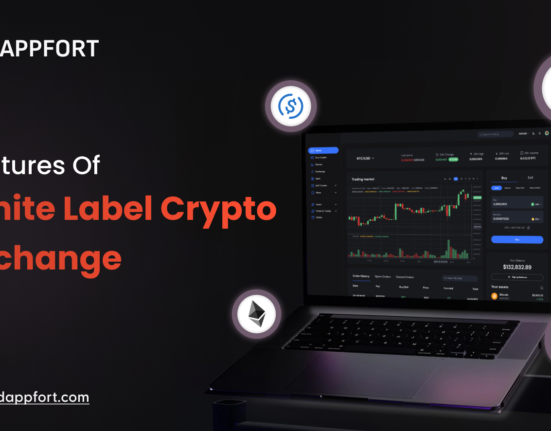
Table of Contents
As the cryptocurrency ecosystem rapidly evolves, crypto exchanges will emerge as the backbone of this digital financial revolution These exchange platforms are more than just marketplaces where people can buy, sell, and consume digital currencies—they are gateways in the future of the global economy. With billions of transactions being processed every day, crypto exchanges are not only transforming the global economy but also opening up new avenues for businesses, investors, and individuals.
One of the most important questions for businesses and investors looking to understand the technology of crypto exchanges is: How do crypto exchanges make money? While revenue generation is important for any business, real success in the crypto exchange industry occurs when the revenue stream matches the needs of customers and provides value to the users The business model that gives them an implementation is successful, and sustainable relationships can lead to lasting and mutually beneficial partnerships.
Let us explore how cryptocurrency exchanges make money, generate income, and remain profitable and sustainable in the ever-evolving digital financial landscape.
What is Cryptocurrency exchange?
A cryptocurrency exchange is a digital platform where people can buy, sell, or trade Bitcoin, Ethereum, and other cryptocurrencies. It works like a digital marketplace, connecting buyers and sellers to communicate. Some exchanges allow you to trade cryptos for a regular currency (like USD) or exchange one crypto for another.

Curious about how do crypto exchanges make money?📊
Learn the revenue strategies that keep them thriving and position your business for success in the digital economy. 🌟
How Do Cryptocurrency Exchanges Make Money?
Crypto exchanges aren’t just platforms for trading—they’re profit hubs with multiple revenue streams tapping into the crypto market’s vast activity. These highly profitable entities have strategies designed to capitalize on market activity. Let’s explore the core ways in which crypto exchanges generate revenue and remain profitable:
- Trading Fees
- Listing Fees
- Loyalty Tokens
- Margin Trading and Leverage
- Staking Services
- Cryptocurrency Lending and Borrowing
- IEO (Initial Exchange Offering) Fees
- Market Making
- Advertising
- Affiliate Programs and Partnerships
- Custodial Fees
1. Trading Fees
Trading fees are the most common fees generated by cryptocurrency exchanges. This fee is charged every time a user makes a trade on the exchange platform and generally ranges from 0.1% to 0.5% of the transaction value. The higher the trading volume, the higher the exchange’s revenue. In addition, some exchanges offer discounts for professional or VIP traders to promote more activity.
- Transaction fees typically range from 0.1% to 0.5% per transaction.
- VIP users or wholesalers usually get a discount.
- Exchanges can charge consumers high fees (immediate trades) and low fees from producers (small orders).
2. Listing Fees
Exchanges charge new projects a listing fee to add their tokens to the exchange platform. This provides visibility for the tokens and credibility for the projects. The fees vary depending on the exchange’s reputation and the market’s demand for the token. Larger exchanges can charge substantial listing fees, sometimes reaching millions of dollars, particularly for high-profile projects.
- Listing fees can range from thousands to millions of dollars.
- Projects benefit from exposure to a large user base.
- Exchanges ensure only serious projects are listed, increasing exchange platform value.
3. Loyalty Tokens
Exchanges often create their own loyalty tokens to incentivize user participation and long-term engagement. These tokens can offer users benefits like discounted fees, access to exclusive promotions, and staking opportunities. As users accumulate and utilize these tokens, the exchange encourages them to stay active and loyal to the platform.
- Loyalty tokens can offer fee discounts and rewards.
- Tokens can increase in value over time, benefiting both users and the exchange.
- Exchange Platforms like Binance use loyalty tokens to drive user retention.
4. Margin Trading and Leverage
Margin trading enables users to borrow money to increase their trading position. Exchanges make money by charging interest on borrowed money. Offering leverage options such as 5x or 10x can increase trading volume and subsequently earnings. This attracts more sophisticated traders looking for higher returns.
- Margin trading enables users to borrow money for large transactions.
- The exchange charges interest on the loaned amount.
- Higher leverage options can increase trading volume and crypto exchange platform revenue.
5. Staking Services
Many exchanges offer staking services, where users can lock in their cryptocurrencies on the web for prizes. In return, exchangers charge a small fee in exchange for wages. This provides users with passive income opportunities, creating a steady income stream for the exchange platform.
- Staking provides users with passive income through closed-end assets.
- The exchanges charge a small fee for the awards as a service fee.
- This service appeals to users who want a safe, low-maintenance way to solidify their cash holdings.
6. Cryptocurrency Lending and Borrowing
Exchanges facilitate lending and borrowing, allowing users to lend their cryptocurrencies or borrow against them. In exchange, the exchange platform earns a portion of the interest. This feature benefits both casual and institutional users, creating liquidity and additional earning opportunities for the exchange.
- Users can lend or borrow assets on the exchange.
- Exchanges earn interest by taking a percentage of the lending fees.
- The service attracts institutional clients and individual traders seeking liquidity.
7. IEO (Initial Exchange Offering) Fees
In IEO, the exchange conducts a token sale to another business, charging a fee for the business or a percentage of the funds raised. This gives businesses instant access to more users and, in exchange, revenue. IEOs enhance user engagement and exchange platform interaction.
- IEOs will issue new tokens that will be sold directly on the exchange platform.
- Exchanges charge fees or a percentage of the money collected.
- The exchange makes money through trading volume and IEO participation.
8. Market Making
Market making involves the exchange of buying and selling assets to ensure there is enough liquidity for users to trade. Exchanges profit from the difference between the buy and sell prices, known as the spread. This helps maintain market stability and attracts traders who benefit from smoother transactions.
- Market makers provide liquidity and stabilize prices.
- Exchanges profit from the bid-ask spread between buy and sell prices.
- Ensures smoother trading, which attracts more users and volume.
9. Advertising
Many exchanges can monetize their platforms by selling ad space. Crypto-related companies, businesses, or businesses pay for banner ads, sponsored posts, and other advertising. This provides additional revenue over and above traditional trading fees.
- Exchanges sell advertising space for crypto companies and businesses.
- Advertising can include banner ads, sponsorships, and promotions.
- Exchanges with high user traffic may charge a premium rate on ad placement.
10. Affiliate Programs and Partnerships
Affiliate programs allow exchanges to pay commissions to users who refer new customers. Exchanges also form partnerships with fintech companies to offer new products, like crypto cards, generating additional revenue through transaction fees. These programs expand the exchange’s user base while providing commission-based income.
- Affiliate programs pay commissions for user referrals.
- Partnerships with companies like Visa generate revenue from crypto card fees.
- These programs help reduce user acquisition costs while expanding the platform’s reach.
11. Custodial Fees
Exchanges offer custodial services, where they securely store large amounts of cryptocurrency for users. These services are especially popular among institutional clients, who require secure and compliant storage. Exchanges charge custodial fees, often a percentage of assets under management, providing a steady income stream.
- Custodial services store assets securely for institutional clients.
- Fees are typically a percentage of assets under management.
- This service helps exchanges build trust and provide security to high-value clients.
Start building your own profitable exchange today! 🚀
Unlock how do crypto exchanges make money 💰 and discover the key revenue streams behind their success.

Additional Revenue Models for Crypto Exchanges
Cryptocurrency exchanges can earn money in many ways beyond just trading fees. With the growing interest in crypto services, they have opportunities to offer extra services and increase their income. Here are some of the additional key ways exchanges can generate revenue.
1. Tokenized Assets and Security Tokens
Some exchanges introduce tokenized real-world assets, such as stocks or real estate, allowing users to trade these assets in a digital format. By listing tokenized assets or security tokens, exchanges can earn listing fees and trading commissions. This attracts institutional investors and broadens the platform’s market reach.
- Tokenized assets enable users to trade real-world assets digitally.
- Exchanges earn fees from listing and trading tokenized assets.
- It attracts institutional investors and diversifies the platform’s offerings.
2. NFT Marketplace and Trading Fees
With the rise of NFT (non-fungible tokens), many exchanges have added NFT markets. These platforms allow users to mint, buy, and sell NFTs, with the exchange charging a transaction fee for each sale or transaction. As the NFT market continues to grow, this could be an attractive coin for exchanges.
- NFT marketplaces allow users to mint, buy, and sell digital collections.
- Exchanges earn a fee from each NFT transaction.
- The increasing popularity of NFTs is creating new opportunities for exchange.
3. Crypto Payment Gateway Fees
Crypto exchanges can offer businesses a payment gateway to accept cryptocurrency payments. In exchange, the exchange charges businesses a fee for processing these payments. This model helps crypto adoption in the real world while providing the exchange with another steady income stream.
- Businesses can accept cryptocurrency payments through the exchange’s payment gateway.
- Exchanges charge a processing fee for each transaction.
- It helps increase crypto adoption by integrating it into real-world commerce.
4. Peer-to-Peer (P2P) Trading Fees
In P2P trading, users can buy and sell cryptocurrencies directly with each other. The exchange acts as an intermediary, offering a crypto exchange platform for secure transactions. The exchange charges fees on these trades, usually as a percentage of the total transaction volume.
- Users engage in direct crypto trading with one another.
- The exchange earns fees by facilitating secure transactions.
- P2P trading offers a decentralized approach, enhancing user control.
5. API Access Fees
Exchanges can offer API access to developers and institutions who need to integrate their trading platform with external applications. These APIs allow third-party services to access market data, execute trades, or monitor accounts. By charging for API access, exchanges generate consistent income from institutional and professional traders.
- API access allows third-party trading platforms to integrate with the exchange.
- Exchanges charge fees for API usage, especially from institutional clients.
- This model is appealing to algorithmic traders, institutional investors, and developers.

Ready to invest in the future of crypto?💼
Launch your secure, scalable crypto exchange platform today with expert guidance! 🚀💰
Is Running a Crypto Exchange Profitable?
Creating a crypto exchange can be a very profitable business, driven by key factors such as trading volume, fees, liquidity, and users. Most exchanges generate revenue by charging trading fees that typically range from 0.1% to 1%, larger forums often choose lower rates to attract more traders. Higher trading volumes can lead to higher profits, and offering new services that advanced trading tools, margin trading and betting for placement can further increase revenues.
However, launching and maintaining successful change comes with challenges. Regulatory hurdles, security risks, and fierce competition can affect profitability. To maintain user confidence, investment in strong security measures is essential, while more resources may be needed to ensure full compliance. Despite these limitations, with the growing demand for cryptocurrencies, advances in blockchain technology make crypto exchanges a more attractive business model migration can be a more lucrative strategy.
Is Now the Best Time to Launch a Crypto Exchange?
Yes, now is the right time to enter the crypto exchange business. The number of crypto users is growing rapidly, along with the demand for exchange platforms, and offering more opportunities for newcomers. If you enter the market today, you can take advantage of these improvements and set yourself up for success.
Partner with Dappfort, a trusted cryptocurrency exchange development company, to develop a high-quality, secure, and reliable trading platform that meets the needs of today’s users to ensure a successful outcome.



